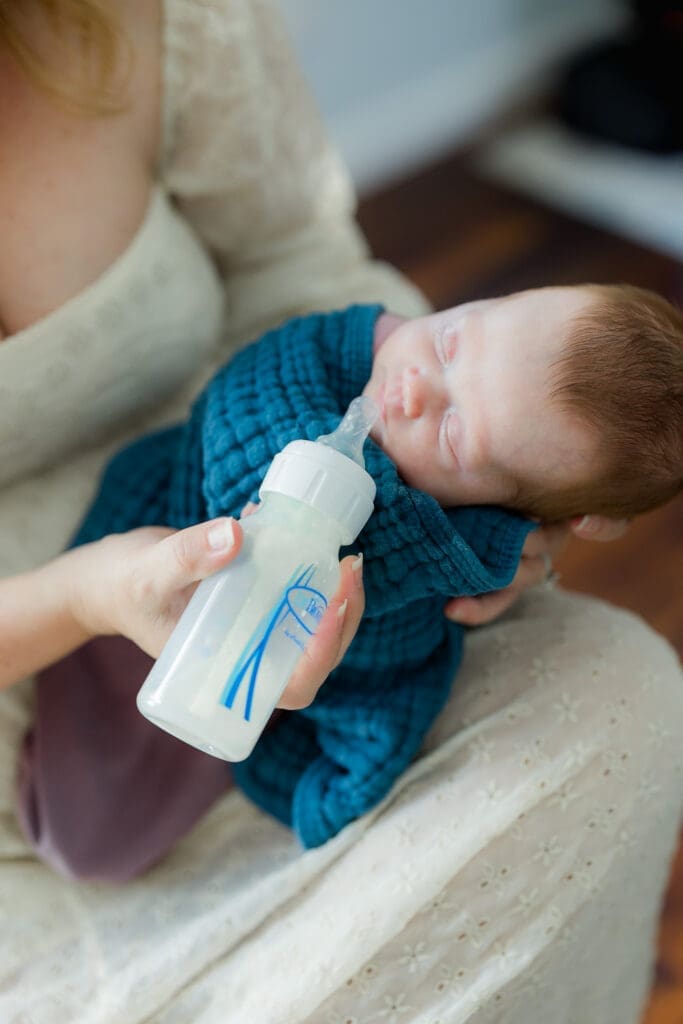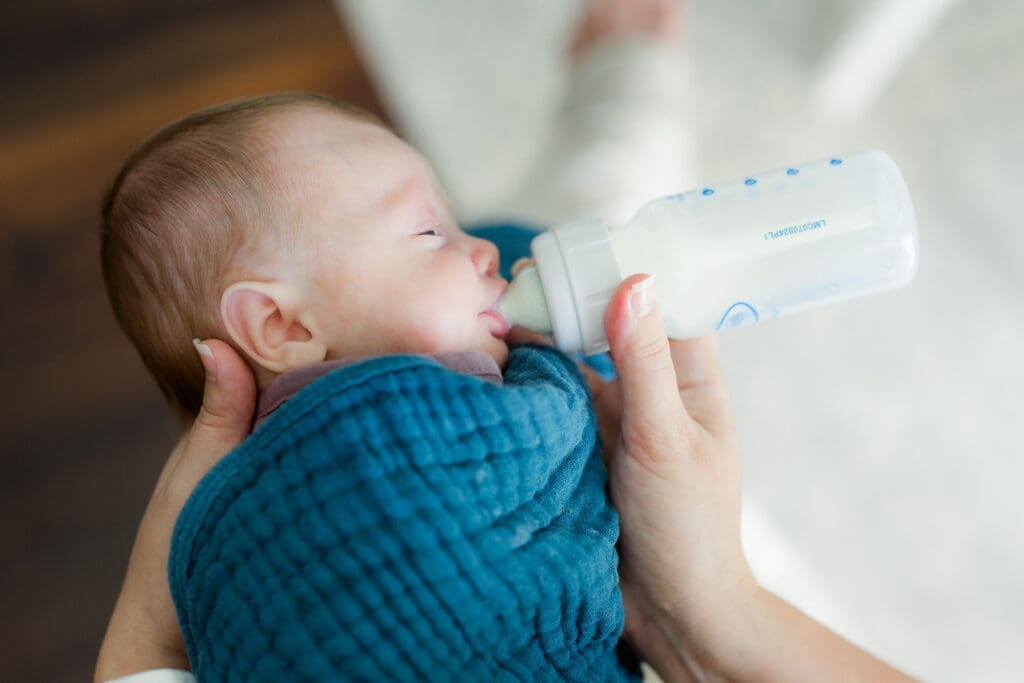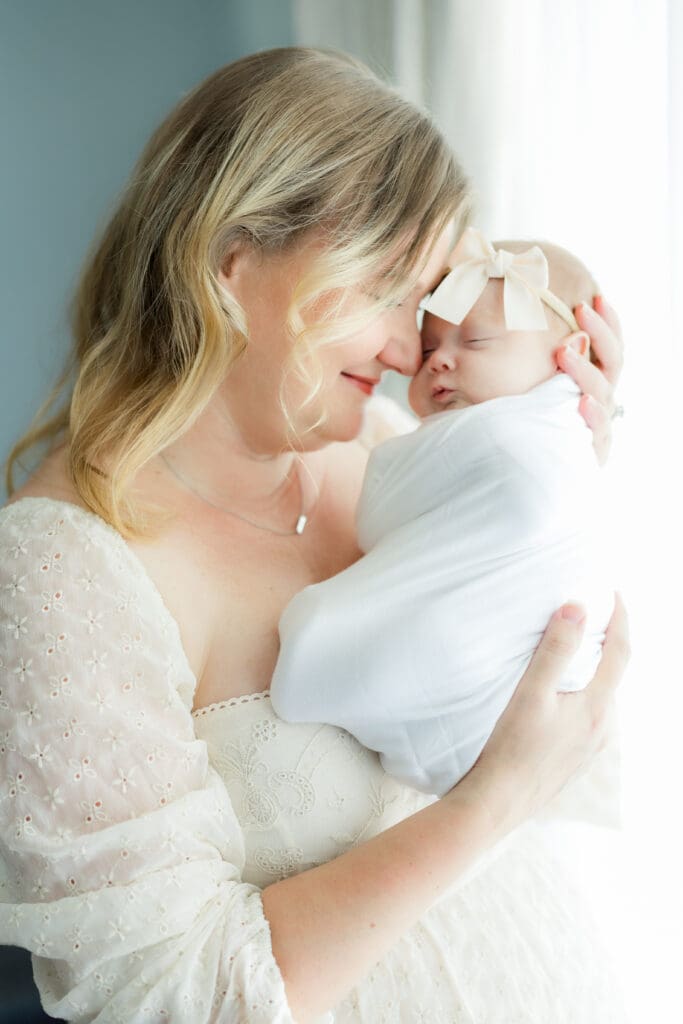
Why You’re Not Doing It Wrong (And Your Baby Isn’t, Either)
If you’re reading this with a bottle in one hand and a sleepy newborn in the other, wondering why feedings are harder than expected, I want you to know something: it’s not just you. And it’s definitely not your baby being “lazy” or “difficult.”
As a NICU and infant feeding therapist working in a Tampa hospital, I share bottle feeding newborn baby tips with parents every single week. These are real, hands-on strategies I’ve seen transform feeding from a stressful guessing game into calm, connected moments.
Many of the families I meet are supplementing breast milk with formula or donor milk because their baby’s bilirubin levels are rising or their weight is dropping too quickly. That’s already a lot to take in — and then the bottle feeding part doesn’t always go smoothly.
It can feel like a failure, but it’s not. Feeding challenges are incredibly common in the early days, and with the right adjustments, they can often be resolved quickly.

When Baby “Falls Asleep” at the Bottle
You may have seen it happen: your baby gets the bottle in their mouth, and instead of eagerly sucking, they suck a few times then drift into sleep. For new parents, this can feel like a mystery with no instructions.
In the hospital, this is when I’m usually called in. Even in a breastfeeding-forward setting (which I fully support!), there are important medical reasons to supplement with a bottle in the early days. The challenge is that most newborns are given thin, fast-flowing milk through a nipple labeled “slow flow” — which in reality, is still much faster than their body is ready for.
Think about it from your baby’s perspective: their instincts and muscles are tuned for colostrum, which is thick and comes out drop by drop. Suddenly they’re getting thin liquid flowing into their mouth much faster than they’re prepared for. It’s a shock — like expecting a leisurely sip of thick, warm cocoa and then being hit with a blast of water.
The natural response? Shut down. Stop sucking. Fall asleep.
The good news is that this isn’t about your baby “refusing” the bottle. It’s about flow, pacing, and comfort — and those things can be adjusted.

Top Bottle Feeding Newborn Baby Tips from a Tampa NICU Therapist
1. Choose the Slowest Flow Nipple Available
When a flow is too fast, babies may gulp, spill, choke, or shut down. This wastes energy and makes feeding harder than it needs to be. In my NICU work, I often see parents surprised at how much of a difference the right nipple flow can make.
If you’re using hospital-provided nipples, know that even “slow flow” might be too quick for a newborn. Look for preemie or ultra-slow flow options. The goal is to give your baby time to coordinate sucking, swallowing, and breathing without feeling overwhelmed.
Example: One Tampa family I worked with was ready to give up on bottle feeding entirely — until we swapped to a Dr. Brown’s preemie nipple. Within a day, their baby was finishing feeds calmly without arching away or falling asleep mid-bottle.
2. Swaddle or Use Skin-to-Skin Before Feeding
Feeding well is not just about milk — it’s about regulation. When a newborn’s body is calm, their feeding reflexes work better.
Skin-to-skin contact adds warmth, a steady heartbeat, and familiar scents that tell your baby, “You’re safe.” It is perfect for breastfeeding and can be done prior to bottle feeding. Swaddling helps contain flailing limbs, keeps reflexes organized, and signals to the nervous system that it’s safe to focus on eating. It is extremely beneficial for a newborn to be swaddled for bottle feeding.
Tip: When you choose to do skin-to-skin, place a blanket over both of you for warmth. Even a few minutes before offering the bottle can make a difference in alertness and coordination.

3. Use Elevated Side-Lying Positioning
This is one of my most-used tips in the NICU. Instead of holding your baby on their back in the cradle position, lay them on their side, with their head higher than their stomach. Support their head in a neutral position — not tilted back or chin tucked too far.
Benefits:
- Mimics breastfeeding posture
- Slows milk flow
- Allows your baby more control over pacing
- Reduces risk of choking or gulping
Example: I recently worked with a mom who was worried her baby was “lazy” at feeds. In reality, her baby was overwhelmed by milk flow. Once we switched to side-lying and used a slower nipple, her baby took the entire bottle without stress — and without needing constant breaks.
4. Protect Their Sleep Between Feeds
We often underestimate how much energy feeding takes for a newborn. If a baby is overstimulated between feeds — passed around to visitors, exposed to bright lights, or kept awake too long — they may not have the reserves to feed well next time.
Tip: Between feedings, keep your baby swaddled or resting on you Skin-to-Skin. Avoid unnecessary stimulation so their nervous system has time to recharge. A calm, rested baby will almost always feed better.
5. Seek Expert Support Early
If bottle feeding is still a struggle after trying these tips, ask for help. In the hospital, I work closely with lactation consultants, nursing, and physicians to troubleshoot feeding challenges. Sometimes a minor adjustment is all it takes; other times, we need to check for oral motor issues, tongue tie, or other factors.
If you’re still in the hospital, ask if a NICU SLP or infant feeding therapist can observe a feed. If you’re at home, reach out to your pediatrician for a referral to outpatient speech therapy for feeding therapy. Early intervention can prevent feeding stress from becoming a long-term hurdle.

Why These Bottle Feeding Newborn Baby Tips Matter
Feeding is about so much more than nutrition — it’s connection, trust, and comfort. When bottle feeding is calm and supportive, both baby and parent can relax. That’s when feeding becomes not just a task, but a bonding experience.
I’ve seen parents walk into the NICU with worry etched across their faces, certain something is “wrong.” And I’ve seen those same parents leave confident, smiling, and enjoying those quiet moments with their baby.
FAQs: Bottle Feeding Newborn Baby Tips
Q: How do I know if my baby needs a slower flow nipple?
If your baby coughs, gulps, dribbles milk, or falls asleep quickly at the bottle, try moving to a slower flow.
Q: Is it okay to switch between breast and bottle in the early days?
Yes — with the right nipple flow and positioning, many families successfully combine the two. Just keep both feeding experiences as similar as possible.
Q: How should I hold my newborn for bottle feeding?
The elevated side-lying position is safe, calming, and supports better pacing.
Q: My baby only drinks a small amount before falling asleep. What should I do?
Check the feeding environment (low lights, minimal distractions), ensure the nipple flow isn’t too fast, and try gentle stimulation like loosening swaddle or gently stroking their cheek.
Q: Can bottle feeding be baby-led?
Absolutely. Offer the bottle, let your baby set the pace, and pause when they pause. Forced feeds often lead to stress for both baby and parent.

Looking for More Calm in Your Motherhood Journey?
Creating calm, connected moments for families isn’t just what I do with my camera — it’s at the heart of everything I do. Whether you’re in the newborn fog or preparing for your first family photo session, I bring the same deep care from my NICU and infant feeding work into every photography session.
If you’re preparing for an in-home or studio newborn photography session in the Tampa area, I’ll help make it gentle and beautiful for your baby. Learn more about my newborn process here.





Comments +